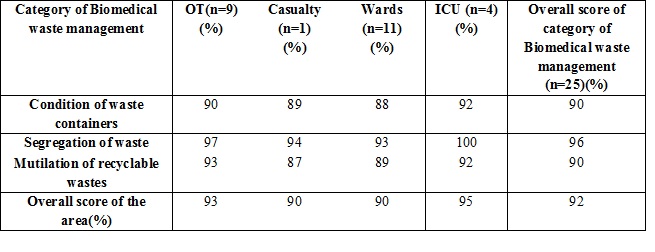A study on evaluation of biomedical waste management in a tertiary care hospital in South India
Abstract
Introduction: Bio-Medical wastes are classified based on their source of generation which includes various risk factors relatedto their handling and final disposal. The segregation of waste at the source of generation is the significant step.The compliance in various categories of biomedical waste management in a tertiary care hospital was evaluated.
Materials and Methods: A checklist containing 17 parameters related to biomedical waste management such as ‘condition of waste containers’, ‘segregation of waste’, ‘mutilation of recyclable waste was prepared and observed for compliance in 25 different patient care areas such as 9 Operation theatres, 1 casualty, 11 wards and 4 ICU. Each area was visited on any 3 non-consecutive days in the study period of 6 months from August 2017 to January 2018. Thus, a total of 6 visits were made to each area and mean percentage scorewas analysed for each area and each category of biomedical waste management.
Results:For OTs, the mean percentage for ‘condition of waste containers’, ‘segregation of waste’, ‘mutilation of recyclable waste’ was 90%, 97% and 93% respectively. In casualty, the mean percentage was 89%, 94% and 87% respectively. For wards, the meanpercentage for these categories was 88%, 93% and 89% respectively; and for ICUs, the meanpercentage was 88%, 100% and 92% respectively.
Conclusion:It was determined that more importance needs to be rested for ‘mutilation of recyclable waste’ especially in wards.
Downloads
References
2. Manual on Solid Waste Management, Ministry of Urban Development, Government of India. Available from http://www.mohua.gov.in. Last accessed on 30/11/18.
3. Collins CH, Kennedy DA. Microbiological hazards of occupational needlestick and 'sharps' injuries. J ApplBacteriol. 1987 May;62(5):385-402.[pubmed]
4. Centre for environment education and technology. Bio–medical waste management – burgeoning issue; 2008.
5. Hem Chandra. Hospital waste- An Environmental Hazard and Its Management. Enviro news 1999;5(3).
6. Bio-medical Waste (Management and Handling) Rules, 1998, Ministry of Environment and Forests, Government of India. Available fromhttp://hspcb.gov.in/BMW%20Rules.pdf.Last accessed on 05/12/18.
7. The Environment (Protection) Act, 1986, Ministry of Environment and Forests, Govt. of India. Available from http://envfor.nic.in/legis/env/env1.html. Last accessed on 05/12/18.
8. Blenkharn JI. The disposal of clinical wastes. J Hosp Infect. 1995 Jun;30 Suppl:514-20.[pubmed]
9. Blenkharn JI. Standards of clinical waste management in hospitals--a second look. Public Health. 2007 Jul;121(7):540-5. Epub 2007 Feb 12. DOI:10.1016/j.puhe.2006.12.005.[pubmed]
10. Nataraj G, Baveja S, Kuyare S, et al. Report: Medical students for monitoring biomedical waste segregation practices--why and how? Experience from a medical college. DOI:10.1177/0734242X07081481.[pubmed]
11. Talaat M, Kandeel A, El-Shoubary W, et al. Occupational exposure to needlestick injuries and hepatitis B vaccination coverage among health care workers in Egypt. Am J Infect Control. 2003 Dec;31(8):469-74. DOI:10.1016/j.ajic.2003.03.003.[pubmed]
12. Debere MK, Gelaye KA, Alamdo AG, et al. Assessment of the health care waste generation rates and its management system in hospitals of Addis Ababa, Ethiopia, 2011. BMC Public Health. 2013 Jan 12;13:28. doi: 10.1186/1471-2458-13-28.
13. Battersby A, Feilden R, Nelson C. Sterilizable syringes: excessive risk or cost-effective option? Bull World Health Organ 1999; 77(10):812–819. 

14. Janjua NZ. Injection practices and sharp waste disposal by general practitioners of Murree, Pakistan. J Pak Med Assoc. 2003 Mar;53(3):107-11.[pubmed]
15. Murakami H, Kobayashi M, Zhu X, et al. Risk of transmission of hepatitis B virus through childhood immunization in northwestern China. Soc Sci Med. 2003 Nov;57(10):1821-32.[pubmed]
16. Bio-Medical Waste Management Rules. 2016 Published in the Gazette of India, Extraordinary, Part II, Section 3, Sub-Section (i), Government of India Ministry of Environment, Forest and Climate Change. Notification; New Delhi 2016. Available from http://mpcb.gov.in/biomedical/pdf/BMW_Rules_2016.pdf. Last accessed on 05/12/18
17. Datta P, Mohi GK, Chander J. Biomedical waste management in India: Critical appraisal. J Lab Physicians. 2018 Jan-Mar;10(1):6-14. doi: 10.4103/JLP.JLP_89_17.[pubmed



 OAI - Open Archives Initiative
OAI - Open Archives Initiative


